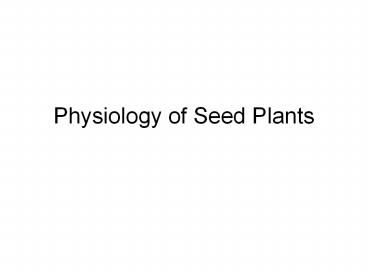Physiology of Seed Plants - PowerPoint PPT Presentation
Title:
Physiology of Seed Plants
Description:
Physiology of Seed Plants Regulating Growth and Development: The Plant Hormones Auxins Cytokinins Ethylene Abscisic Acid Gibberellins Molecular basis of Hormone ... – PowerPoint PPT presentation
Number of Views:232
Avg rating:3.0/5.0
Title: Physiology of Seed Plants
1
Physiology of Seed Plants
2
Regulating Growth and Development The Plant
Hormones
- Auxins
- Cytokinins
- Ethylene
- Abscisic Acid
- Gibberellins
- Molecular basis of Hormone Action
3
Hormones
- Chemical signals that help both plants and
animals regulate and coordinate metabolism,
growth, and differentiation. - Phytohormones- plant hormones
4
Three basic elements of Hormones
- Synthesis of the hormone in one part of the
organism - Transport of the hormone to another part (target
tissue) - Induction of chemical response
5
Phytohormones
- Produced in tissues or glands
- Very active in small quantities
- Pineapple Ananas comosus for example are only 6
micrograms of indoleacetic acid (IAA) a common
plant hormone per kg of plant material.
(analogous to a needle in 20 metric tons) - Can stimulate or inhibit depends on chemical
structure and how it is read by the target tissue
6
Five classes of plant hormonesThe Classic Five
- Auxins
- Cytokinins
- Ethylene
- Abscisic acid
- Gibberellins
7
Auxins
- Charles Darwin and Francis Darwin- The Power of
Movement in Plants 1881
8
(No Transcript)
9
(No Transcript)
10
(No Transcript)
11
(No Transcript)
12
(No Transcript)
13
(No Transcript)
14
(No Transcript)
15
(No Transcript)
16
(No Transcript)
17
Additional chemicals used by plants
- Brassinosteroids- naturally occuring polyhydroxyl
steroids (tissue growth) - Salicylic acid- phenolic compound similar
structure to aspirin implicated in defense
responses - Jasmonates- class of compounds known as oxylipins
plant growth regulation and defense - Polyamines- strongly basic molecules found in all
organisms (bacteria, fungi, animal, plants) are
essental for growth and development and affects
cell division - Systemin- a polypeptide functions as a long
distance signal to activate chemical defenses
against herbivores. - Nitric oxide (NO) serves as a signal in hormonal
defense responses.































